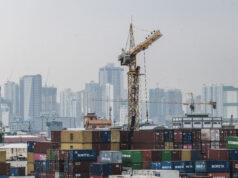BSP slashes policy rate to record low

THE Bangko Sentral ng Pilipinas (BSP) unexpectedly cut benchmark rates on Thursday, its fourth easing move this year, to help boost the economy amid dimmer global prospects.
The Monetary Board, at its policy meeting, slashed the rates on the BSP’s overnight reverse repurchase, lending and deposit facilities by 50 basis points (bps) to new record lows of 2.25%, 2.75 and 1.75%, respectively, effective Friday, June 26.
This brought cumulative reductions for this year so far to 175 bps as the central bank looks to prop up the economy amid the coronavirus pandemic.
“The Monetary Board observed that domestic economic activity has slowed with the enforcement of necessary protocols to slow the spread of the virus in the country,” BSP Governor Benjamin E. Diokno said in an online briefing yesterday.
“At the same time, the outlook for global growth has deteriorated further as considerable uncertainty still surrounds the extent of the health crisis. The Monetary Board noted that even as economies begin to reopen, the global recovery would likely be protracted and uneven. Hence, there remains a critical need for continuing measures to bolster economic activity and support financial conditions, especially the effective implementation of interventions to protect human health, boost agricultural productivity and build infrastructure,” he said.
Mr. Diokno said the Monetary Board decided to cut rates amid a “benign inflation environment” to help soften the impact of these global risks on Philippine economic growth and boost market confidence.
“Even as domestic liquidity dynamics and market function continue to improve owing to prior liquidity-enhancing measures, the Monetary Board believes that keeping an accommodative stance will further ease the cost of borrowing and ensure ample credit and liquidity in the financial system as the economy transitions toward recovery in the coming months,” the central bank chief said.
Only three out of 13 economists in a BusinessWorld poll last week predicted a rate cut at yesterday’s meeting, saying a 25-bp cut could be on the table.
Earlier this month, Mr. Diokno had said they are “happy” where benchmark rates are but noted the central bank will use its “full powers” if it sees a need for further easing based on economic data.
PROACTIVE
BSP Deputy Governor Francisco G. Dakila, Jr. on Thursday said the inflation outlook for the year was raised to 2.3% from the 2.2%, while the 2021 forecast was likewise hiked to 2.6% from 2.5%. Both forecasts are closer to the lower end of the BSP’s 2–4% target for the year.
“The main factor that led to the revision of the forecast is the increase in global oil prices, but this was partly offset by the weaker economic growth both domestically and globally, as well as the continued stability of the peso,” Mr. Dakila said.
Inflation settled at 2.1% in May, slower than the 2.2% in April and the 3.2% a year earlier. This brought the year-to-date inflation average to 2.5%.
The official said the BSP’s move to cut rates is a proactive stance given recent developments.
“For example, we continue to see very challenging global conditions, with many multilateral institutions reducing their forecast for global economic growth,” Mr. Dakila said.
The International Monetary Fund (IMF) said in its World Economic Outlook Update published on Wednesday that it sees the global economy shrinking by 4.9% this year, worse than the three percent contraction it estimated in April as the fallout from the virus looks worse than initially anticipated.
The IMF said it now projects a 3.6% contraction in the Philippines’ gross domestic product this year. This is a sharp reversal from the IMF’s baseline 6.3% growth forecast given last year and the 0.6% growth outlook given in April.
“The pace of recovery will depend on the speed at which we recover our confidence, especially consumer confidence, and lowering interest rates will encourage consumers to spend and also businesses to at least start…production activities again,” Mr. Dakila said.
Asked if the BSP is looking at “unconventional” policy moves like those implemented by other emerging economies, Mr. Dakila said the central bank continues to have enough elbow room, as proven by the latest 50-bp rate cut.
“Before we can do unconventional monetary operations, we can still make use of the policy space,” he said. “Our reserve requirements still continue to be one of the highest in the region. So there may be room to accelerate RRR (reserve requirement ratio) adjustments should the need arise.”
He said the BSP’s policy adjustments thus far have already freed up $1.6-trillion in liquidity.
The Monetary Board has authorized Mr. Diokno to cut banks’ RRR by up to 400 bps this year.
The BSP cut universal and commercial banks’ RRR by 200 bps in April to 12%. Meanwhile, the reserve ratios of thrift and rural lenders stand at four percent and three percent, respectively.
MORE EASING?
Analysts were mixed on the central bank’s future policy moves. The Monetary Board still has four policy reviews scheduled this year, with the next one set for Aug. 20.
“After the flurry of rate cuts and infusion of liquidity, today’s move may be the last from the BSP in 2020 with Mr. Diokno likely in favor of approximating positive real policy rates,” ING Bank N.V. Manila Senior Economist Nicholas Antonio T. Mapa said in an e-mail.
On the other hand, Alex Holmes, an economist at Capital Economics, said inflation will not be a barrier to further easing in the near term.
“[W]ith the pandemic weighing heavily on the economy, we doubt this will be the bank’s last move,” Mr. Holmes said in a note sent to reporters.
For his part, UnionBank of the Philippines, Inc. Chief Economist Ruben Carlo O. Asuncion said the BSP eased further as it sought to “get ahead of the curve,” noting the move was “preventive rather than reactive.” — Luz Wendy T. Noble



